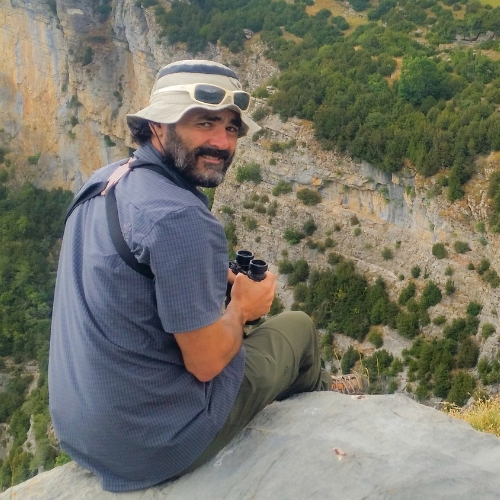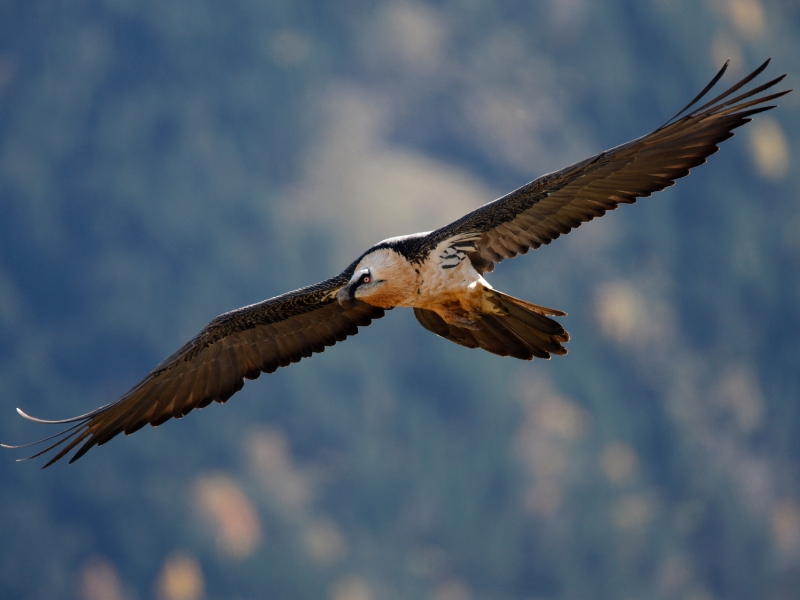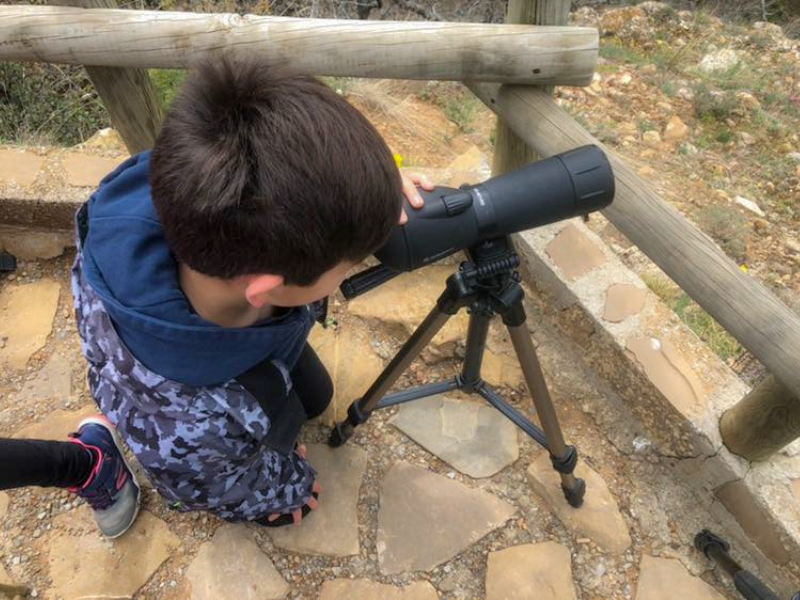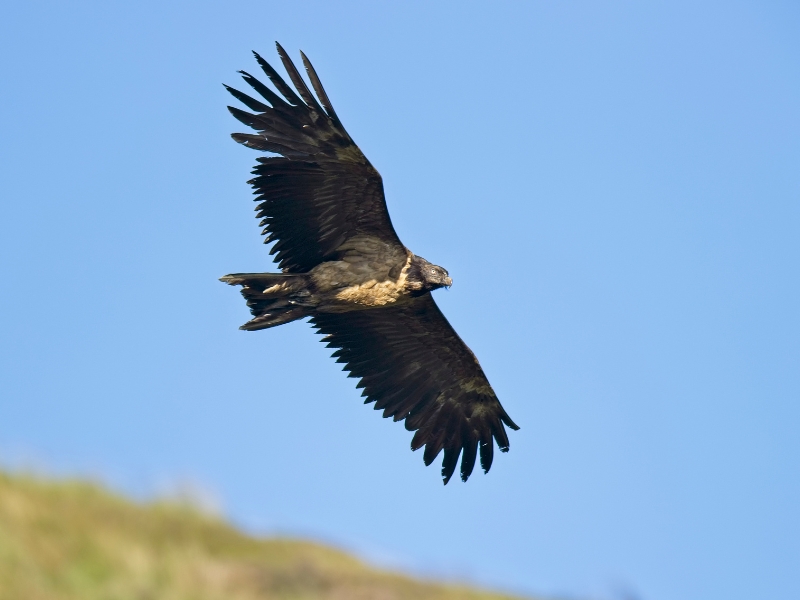lammergeier pyrenees
Discover the most popular bird in the Pyrenees in the best enclave in the province of Huesca and the best observation possibilities with your specialised guide.


Hello! welcome to the Tour to see the biggest bird in Spain. If you have any questions, you can ask me by clicking on the Whatsapp button
Alberto Marin, guide specialised in birds, ex-agent of the Bearded Vulture Foundation.
Watch Lammergeier in Pyrenees
The province of Huesca, in the Pyrenees, is the best place on the planet to observe the lammergeier because it has the highest density of these great birds per km2. This is why we call the Pyrenees Bearded Vulture Country.
There are two types of people in the world: those who have seen the Bearded Vulture and those who have not.
Because seeing is not the same as observing, access the best locations to see the Bearded Vulture in the Pyrenees. Take advantage of your guide’s experience to observe the bearded vulture in Huesca, near Aínsa.


Observing includes getting to know it in depth, positioning yourself in the best location and discovering its habits in order to get the best impressions of this majestic bird in the shortest possible time.
If you are here, you are an observer
Whether you are looking for an enjoyable family experience or you are a bird lover, this tour will allow you to discover what lies behind the impressive flight of the bearded vulture.
My mission is for you to enjoy an overall nature experience that will revolve around the bearded vulture.
Pyrenees Lammergeier Tour
Ideal for families due to its low difficulty. There are shaded areas all along the route, scroll through the photos!
What does the Tour of the Bearded Vulture of the Pyrenees include?

Optical Material
Watch the flight of the Lammergeier up close with 10×42 binoculars that you have at your disposal during the whole route. You can also observe through the telescope from the viewpoints.

Specialist Lammergeier Guide
Take home a truly enriching experience that goes far beyond just watching a bird in flight. Get to know it, observe it and enjoy a pleasant experience with an answer to any curiosity you may have.

Right Place, Right Time
Are the bearded vultures feeding in the feeding areas today, or are they probably in their roosting areas? And if it has rained, where can I find them?
The Tour Lammergeier Pirineos answers all these questions in its own right.
The Pyrenees Bearded Vulture Tour is done in small groups (maximum 7 people) for a better experience.
Lammergeier Tour Value
4 hours- Minimum 3 people. Smaller groups, write me on Whatsapp
- Optical equipment: individual binoculars and telescope.
- Specialised Guide: Discover much more
- Right place, right time
- Optional Private Tour
Ask for Private Tour on Whatsapp
What do they say about observation experiences?
Phases of the Tour Lammergeier Pirineos

Book your day
Once you book your Lammergeier Tour, we agree the time and you receive the location of the meeting point. The location is easily accessible so no 4×4 transport is needed. If you still need to be picked up from your accommodation, don’t hesitate to let us know.
Meeting point
You receive binoculars and instructions on how to use them. The walk begins above a large gorge. This location allows a strategic position to see the Bearded Vulture and other birds, often flying at your height.


Observation
There are different viewpoints where you can stop to look through the telescope. This is a resting area not only for the Bearded Vulture in the Pyrenees, but also for the Griffon Vulture, Egyptian Vulture, Kite…
Despite having great visibility towards the gorge, we walk along the edge of the forest; so you can enjoy constant shade.
How close will the bearded vultures come? Only Mother Nature knows. You will have done your part, you are in the right place at the right time with the right optical equipment ready.
Return
You have become an expert on the bearded vulture, you can easily distinguish its silhouette and no longer confuse it with a vulture.
The return is quick. Once we are at the last viewpoint, the return trip takes about half an hour.

Bearded Vulture Guide Pyrenees

My mission is for you to enjoy the bearded vulture and its environment in an enriching way so that you really get to know this beautiful bird and its nature.
For some years I had the good fortune to work at the Lammergeier Foundation. All I have learnt during this period and my experience in the observation of the Bearded Vulture will be at your service during the Tour.
Do you have any doubts? Ask directly to the whatsapp button!
Lammergeier Huesca
The province of Huesca is the area of the planet with the highest density of bearded vultures per km2. For this reason, it is the ideal place to observe them; and where we carry out the Tour.
Currently, the Bearded Vulture population in the Pyrenees is close to a thousand specimens, but it reached alarming lows in the seventies.
The Pyrenees, and the province of Huesca in particular, was the refuge of the Lammergeier in the middle of the 20th century when it was close to extinction.

Quebrantahuesos Aínsa
Aínsa is an ideal place to discover more about the bearded vulture in Huesca due to the presence of the Ecomuseum of Aínsa in the town’s castle.
Furthermore, in Aínsa there is a dunghill or supplementary feeding point for carrion-eating birds where the bearded vulture also goes. A magical combination of its title of one of the most beautiful villages in Spain and its wild nature.
Quebrantahuesos Ordesa
If you want to see the Lammergeier in Ordesa, you must choose the highest sectors and the sun-facing areas, where it has a preference.
The disadvantage of Ordesa is that you have to walk up the valley to reach the best areas to observe the Bearded Vulture, and access by vehicle is limited.
For this reason, the Bearded Vulture Pyrenees Tour offers the most comfortable and educational option for its observation in an easy route.
The area of the Ordesa y Monte Perdido National Park with the greatest probability of sighting the Bearded Vulture is in the valleys next to the Escuaín Gorges (an area close to where we do the Tour).
In this valley we discovered the “rompederos”, areas of the Pyrenees where the Lammergeier throws its long bones so that they can be broken into smaller pieces and swallowed.

Ordesa, Historic Lammergeier
The Ordesa y Monte Perdido National Park played a fundamental role in the conservation of the Lammergeier due to the maintenance of the traditional livestock activity with the presence of domestic ungulates (goats and sheep) during a good part of the year in the medium and high mountain territories; at times when it was close to extinction.
On the other hand, the abundance of other animals such as chamois and wild boar in Ordesa guaranteed bone remains for the bearded vulture during the winter months.

In addition, a habitat rich in rocky cliffs and with relative tranquillity safeguarded the Lammergeier until a conservation and recovery plan was put in place, which seems to be on the right track.
Best date to see the Lammergeier in the Pyrenees
The Lammergeier is visible every month of the year in the Pyrenees. Although it is true that in the winter months it remains more focused on its territory with the care and feeding of its chicks.
Laying takes place between November and December and the chicks hatch after an incubation period of fifty-three days.
The chicks are incubated by both conspecifics during the cold Pyrenean winter and, as a general rule, only one bearded vulture chick is born, although sometimes two can be born within six days of each other.

The Lammergeier is a cainite species, so the most adult of the hatched birds will be aggressive towards the second one, even killing it or throwing it out of the nest.
It will take 120 days in the nest for a new generation of bearded vultures to take to the skies of the Pyrenees.
What makes Lammergeier special?
The lammergeier is a carrion-eating bird of prey that feeds on the bones, sinews and remains discarded by other scavenging birds such as vultures.
It has a wingspan of almost three metres from wingtip to wingtip.
In the adult phase it has a characteristic rusty orange colour, which it obtains from bathing in areas with mud rich in iron ore, so abundant in the Pyrenees.
Seen close up, a red membrane around the eye stands out against the yellow of the cornea.

The crossbow-shaped silhouette and its characteristic lozenge-shaped tail will help us to distinguish the bearded vulture in flight.
This sharper shape of the wings and tail will become more defined with age, so that we can distinguish several phases in the lammergeier according to its age:
- Young from 1 year old
- Juveniles from 1 to 3 years old
- Sub-adults from 4 to 6 years old
- Adults over 7 years old
Bearded Vulture Recovery Plan in the Pyrenees
The province of Huesca has several supplementary feeding points that have allowed the recovery of the Lammergeier in the Pyrenees.
At these points, the bearded vulture is provided with bone remains in accordance with the time of year.
The species is currently in a phase of expansion, so the territories of the Cantabrian coast and the Iberian system are the most favourable for colonisation by new individuals.
Gypaetus Barbatus
The scientific name of the Lammergeier ( Gypaetus barbatus ) gives us some more clues about its physical characteristics. It comes from the Greek “Gyps”: vulture and “aetos”: eagle and from the Latin “barbatus” for its characteristic knob that hangs below its beak.
Aragon Birding Club

The Birding Aragón Product Club guarantees the specialisation of birdwatching experiences based on quality criteria established by all members.
Are you looking to observe other birds besides the bearded vulture in the Pyrenees? Discover the Birds of Prey Tour
Always look for this logo in case you decide to hire another company. If you have already decided, but you have doubts: Write me now.















